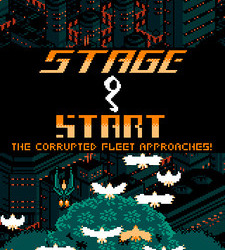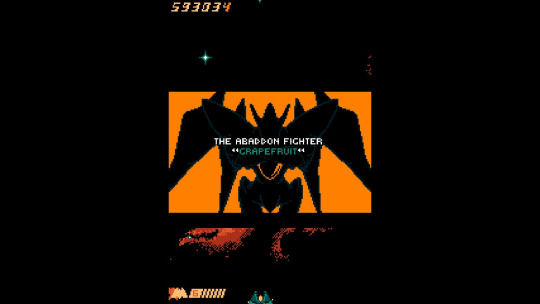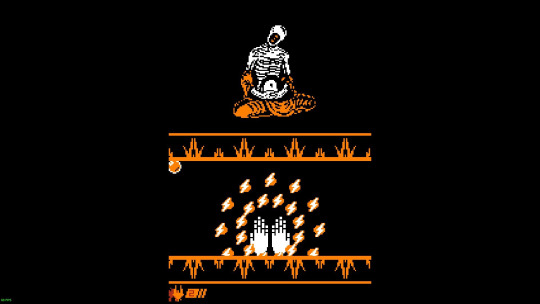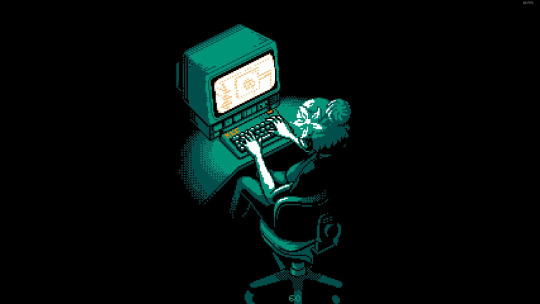#radiant silvergun
Explore tagged Tumblr posts
Photo

Over on the Patreon - we have a look at the awesome shmup 'Radiant Silvergun' on the SEGA Saturn! Check it out by following us for free at http://www.patreon.com/Rlan! Support us on Patreon
22 notes
·
View notes
Text


Recent get. A second Sega STV Titan Motherboard. Radiant Silvergun and Shienryu running side by side.
134 notes
·
View notes
Text

I continue to expand what started as a "six fan arts"
#gradius#rtype#thunder force#devil engine#pawarumi#jet lancer#ikaruga#darius#sine mora#chorus#radiant silvergun#zeroranger#eschatos#natsuki chronicles#axelay#judge spear#rolling gunner#gley lancer#drainus#shmups#six fanarts#pixel art
73 notes
·
View notes
Text
041: What makes Zeroranger special, anyway?

CANON FIRE is made possible by the generous contributions of readers like you. Support more writing like this on Patreon. Thank you!
Developed over a decade and layered in mysteries, Zeroranger is a shooter that’s received acclaim from both STG* fanatics and first-timers for the ways it bends genres. But for all its talk about the ways it pays homage to the genre, and the insistence that it’s something special, Zeroranger almost never gets talked about in plain terms, out of fear of spoiling the surprises that await first time players. That level of caution from its fans is almost admirable, but it leaves what makes the game special undiscussed, and makes it hard for both curious players wondering what the big deal is, and leaves Zeroranger’s best ideas unappreciated.
With that in mind I’ll be doing a deep dive into Zeroranger’s design, with no limitations on what I talk about or spoil.

On a basic level, Zeroranger is a vertically scrolling STG that borrows ideas from a variety of genre classics, paying homage to them through bosses, stage layouts and game mechanics. After each stage you’re given a choice between one of two weapons, each which will become useful in the next stage, but in different ways, with variations between the two playable ships. After the first stage you get a choice between back and side firing weapons, the second unlocks a lock on laser or chargeable shot, and the penultimate boss fight--against Grapefruit, the ship previously thought to be destroyed during the first attack on the enemy--unlocks a mech transformation with a powerful melee weapon that stacks damage and protects you from enemy attacks.
Each weapon allows varied interactions with the level design, covering different areas of the screen and allowing you to approach enemy patterns in a new way. Since you can’t have both weapons of each tier, you’ll have to choose which weakness you’ll accept, and pair it with other weapons that can cover that weakness. It encourages repeat playthroughs to try different strategies and learn the stage layouts, which is good, because Zeroranger will demand repetition.

At the core of Zeroranger is the theme of karmic cycles, repackaging long standing genre concepts in a way that ties them to the ongoing narrative. Like Neverawake, Zeroranger plays with the concepts of Loops--second playthroughs that remix the original stages--but here it acts closer to something out of the Nier series. The initial playthrough is only setup, with a repeat playthrough being the de facto second act, with altered context that builds on your original understanding, followed by a third and final act that brings a proper conclusion.
The karmic themes even affect the meta progression of Zeroranger. Score contributes towards earning the next of nine total continues, used to retry a stage from a checkpoint after death. Continues are represented by the nine orbs that fill out a wheel at the end of the run, which itself resembles the Wheel of Samsara, often used by Buddhists to describe the cycle of existence that mortal beings are subject to.

By framing each attempt as another cycle or reincarnation, it implies that each death has in fact happened, and the only way to escape the cycle is with enough perseverance and knowledge. It blows up the scale to a cosmic degree, and makes your journey to the end of the game, and the knowledge you build of its world, into a form of mechanical and narrative progression.
This knowledge of the world becomes integral to the second loop, which introduces major changes to the patterns and layouts of the first loop, but allows you to return with all your weapons. With these previously unavailable weapons you can easily dispatch enemies that were hard to deal with, and details that seemed mysterious on the first loop fall into place. One of my favorite examples of this are the enemies who appear in the background, before flying into the foreground to attack. On the first loop they seem like a cool, decorative detail, but on the second loop, with the lock-on laser available, suddenly they’re targets you can pick off before they get a chance to attack.

The final act begins when you meet the Grapefruit for the second time and reveal your mech form, allowing you to have a proper duel where they’ll whip out several abilities, including more powerful versions of your own weapons, revealing why they were the first choice in dealing with the enemy.
After defeating Grapefruit you’ll once again face the final boss, but this time instead of the boss rush of the first loop, they’ll give up and offer you another power up.
Here Zeroranger shifts into its final act, requiring you to solve a series of puzzles before gaining access to the true ending. Grabbing the powerup shows you the “ending” and puts you into a loop where you’ll replay the first stage in Final Boss mode, leaning harder into Zeroranger’s CAVE** influences by changing out your default weapons for a Dodonpachi style barrage of bullets and bombs. Completing the stage and grabbing the powerup puts you into another brief minigame before glitching out and returning you to the title.

To escape this you’ll need to reject that final powerup, either within the Final Boss stage or before, during the boss room where the boss rush takes place. By rejecting the offering you gain access to Despair, the real final boss hidden beneath the facility, who naturally has several phases to complete. The first phase is a puzzle itself, requiring you to carefully observe the orbs emitting the attacks, and time your own attacks to destroy them close to simultaneously, or otherwise be stuck helpless in yet another looping trap.
Completing the first phase reveals the true form of the final boss, Despair, a suitably terrifying challenge with a massive suite of attacks whose design could inspire its own essay. Compared to the cerebral challenges preceding it, this final form is more straightforward, but learning the complexities of the patterns often felt as hard as the combined challenge of every obstacle met on the way here.

Defeating Despair reveals the true final boss challenge--a sequence that reveals the origins of Zeroranger’s world, and connects several unresolved narrative threads. Not only must you complete it completely stripped of your previous arsenal, but you’re given a single chance to do so.
Not quite understanding the gravity of what the game was implying there, I took on the final challenge after an exhausting struggle with Despair, desperate to finally see the ending--only to have my save deleted after I failed.
Not only do you need to scale the mountainous challenge of defeating Despair, but you need to complete it with continues to spare, as each continue orb becomes a health point for your final confrontation. In addition, you have to quickly adapt to playing without any of the weapons you’ve built familiarity with during your playtime, and learn the new boss patterns on the fly while unraveling how exactly you can damage the boss. Practice runs are impractical, as you’ll have to complete the whole game at least once before returning, making the minimum time between attempts nearly an hour, if you’ve complete mastery of the rest of the game.

So I cheated. I downloaded my save from the cloud, backed it up, then went back and completed it on my third try, after restoring my save twice. As I finished the final challenge, Zeroranger left me with the same message it began with:
May you attain enlightenment.
By circumventing the challenge, by failing to persevere in the face of disaster, I’d arguably failed this goal. I’d given in to my material desires and skipped the suffering necessary to achieve the knowledge needed to break free of the cycle. Fitting then, that Zeroranger’s conclusion is one that’s hopeful, but open ended, implying that this current cycle has been broken, but the events that caused it may one day repeat themselves.
Then Zeroranger deletes your save.

Records carry over, and the color palette and story change to reflect your achievement, but progress unlocking stages is once again reset. You’re free of the meta trappings of the story, but are given one more reminder of how temporary progress is, and challenged one more time to complete a run to get the complete credits sequence.
It’s a novel approach to player progression in a STG that not only reframes common genre ideas with a thematic approach, but slowly pushes players towards goals that the genre diehards naturally shoot for. By visually indicating the progress towards extra lives and continues through its score counter, it alerts players towards the importance of scoring for continued survival as well as the leaderboards, and encourages them to look for opportunities to maximize score.

The harsh requirements to witness the ending almost guarantee that a player will be forced to start over, and unless they cheat (guilty), forces them to learn the stages and scoring systems to quickly earn back their progress. That process, and the need to hold onto as many continues as possible for the finale, pushes them closer to attempting the 1-credit clear, what most STG players consider the first major milestone in learning a game. Simply put, it’s a run where you complete all the stages in the game without using up a continue, and often denotes mastery.
The parade of secrets and homages, alongside the narrative driven recontextualization of game mechanics and premise shifting final acts create a novel approach for both genre veterans and newcomers, upending expectations with each new twist. Zeroranger’s revelations mark it as equal parts mystery and action game, and asks you to dig deeper, coming to an appreciation of its layered design in the process.

Personally, as much as I respect the final act’s commitment to delivering on Zeroranger’s themes of struggle, persistence and reincarnation, the harsh penalty of deleting your save was demotivating to a degree that I didn’t feel was worth the tension it imparted. I can only imagine how a less experienced player might feel, struggling for hours to reach that point, and possibly being unsure if they could reach it again. Zeroranger’s patterns and stage design are often less demanding than most of its contemporaries, but they come with harsher penalties for failure.
Even given that, it’s not hard to see why Zeroranger captured the imagination of so many. Designed intentionally to be approachable, with enough mystery to satisfy the lore hungry theorycrafters, Zeroranger provides many entry points. Paired with its striking two color palette and memorable soundtrack, it paints the picture of a greater world beyond its borders. The drawn out finale demands you engage Zeroranger with your entire attention, and its dramatic set pieces and score bring an emotional climax that the more traditional arcade style titles often can’t spend the runtime on.
Even after the credits roll, Zeroranger leaves plenty to discover, both within its boundaries and outside. Its themes of karmic cycles and open-ended conclusion invite you to explore it further, and its homages and secrets point to other games and worlds whose influence helped bring it to life. It’s an introduction to the mindset of a genre fanatic, an homage for all those who’ve already journeyed through the genre to arrive here, and an invitation for those who haven’t to share in that same passion.

--- Zeroranger is availble on PC. Homebrew ports are availble for the Switch and Linux based handhelds via Portmaster.
--- *STG: ShooTing Game, aka SHMUP or Shoot-Em-Up. A community term for the genre of arcade style shooters used to differentiate them from the more common first and third person shooters.
**CAVE: Developer of several major entries in the genre, and credited with popularizing the danmaku (bullet curtain) or bullet hell sub-genre. Their games are often marked by complex enemy bullet patterns, with a powerful player arsenal that can hit many parts of the screen at the same time.
#zeroranger#system erasure#stg#shmup#action#switch#pc#steam#homebrew#puzzle#radiant silvergun#ikaruga#cho ren sha#guxt#canon fire
25 notes
·
View notes
Text
The Steam version of Radiant Silvergun releases today. It is also available digitally for the Switch and Xbox 360.

13 notes
·
View notes
Note
Playing Penny's Big Breakaway has made me think a lot about Treasure's games lately. How do you feel about Treasure as a studio and do you have any favorites from them?
I kind of have always appreciated Treasure more from a distance. They were made up of former Konami people, and one thing I feel like classic 16-bit Konami is known for is REALLY, REALLY difficult games. Gradius 3 and Contra 3 and Castlevania 3. Three for three. And also giving you difficulty options but then punishing you if you played on anything less than the hardest setting.
And Treasure carries some of that sensibility forward. So generally I play a lot of Treasure games, admiring the scenery and the ideas, until I get frustrated and then I go play something else.
So, like, I've only ever seen a couple levels of Dynamite Headdy. A couple levels of Gunstar Heroes. One level of Alien Soldier. And when it comes to something, like, say, Silhouette Mirage, I've never even tried touching it because Working Designs localized it and apparently made it even harder. (Thanks, Vic)
I appreciate how they pushed the hardware and they have cool sense of aesthetics, but I cannot actually say I've loved any of their games. Not in the way they deserved. They're just right on that edge of being a little too aggressive for me to click with. I liked what they did, I'm glad they got to do it, it enriched a lot of gaming culture, but... it's just not for me. They carry a little too much of that bullet hell shooter soul.
And once you get past a certain point, like post-Dreamcast Treasure, it starts feeling like a completely different beast. Their games start feeling really toothless and boring (the opposite problem).
Like, the only Treasure games I've finished are Gunstar Super Heroes and Advanced Guardian Heroes on the Gameboy Advance, and it does not make me proud to say that. Those aren't bad games, don't get me wrong, but I don't think they're great games. I guess Astro Boy: The Omega Factor was them, too. All of them have this problem where it feels like they're just, like, missing something, you know?
A special little spark, or a certain game mechanic to anchor the gameplay around, or just... something. Otherwise, they have half of a good idea and a lot of nostalgia.
So I can't really say I have any Treasure favorites. But there are also a lot of Treasure games I've never really played -- haven't touched Radiant Silvergun, I own the original Guardian Heroes on XBLA and never booted it up, never played Bangai-O, or Sin & Punishment, and so on. Maybe there would be something in there that would click with me.
#questions#biggnife#treasure#gunstar heroes#guardian heroes#radiant silvergun#sega#silhouette mirage#konami
5 notes
·
View notes
Text





#radiant silvergun#sega saturn#The pc port of Radiant Silvergun is quite good!!#Im so close to the last stage but god everything is so tough even with a save file
4 notes
·
View notes
Photo

I don’t have to be jealous of my XBox 360 avatar anymore~!
Lies, she still has an RC version of the ship to play with.
9 notes
·
View notes
Link
#activision#ai#animal crossing#anthony fantano#crash bandicoot#Crowdfunding#ebay#feminist frequency#french bread#fromsoftware#Kickstarter#lego#limbus company#memes#nintendo#project moon#radiant silvergun#tcg#tcgplayer#tiktok#trading cards#under night in-birth#youtube#yuka kitamura
3 notes
·
View notes
Photo

Encountered An Assailant 'Radiant Silvergun' SEGA Saturn
206 notes
·
View notes
Text
Radiant Silvergun
88 notes
·
View notes
Text
Serii Game of the Week: Radiant Silvergun

Radiant Silvergun is this really interesting shoot ‘em up (shmup) developed by one of my favorite companies, Treasure. Other games by them include:

:)
RS is a unique shmup since it doesn’t have any power ups, you just get to start with 6 total weapon variations that are upgraded as you build up chains. The story is a pretty interesting one too, told non-linearly with full-on anime cutscenes depicting the end of humanity.
This game has one thing that might make some look the other way:
This game is hard. Like, really fucking hard.

Now for those of you who play shmups this game is just kinda hard because of the really complex chain and scratch system. HOWEVER, the story mode can save your weapon progress which allows you to keep dying until your weapons are powerful enough to blast through the enemies even if you are kinda bad at these types of games. Still though, this game is incredibly fun and I highly recommend giving it a go. RS is available on Xbox One/Series and is now available on switch, so go check it out!
3 notes
·
View notes
Text
youtube
finally some good food
3 notes
·
View notes
Text
Radiant Silvergun releases today on Steam. It is also available digitally for the Switch and Xbox 360.

7 notes
·
View notes

